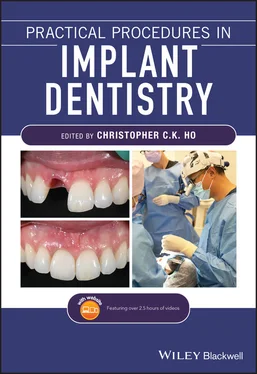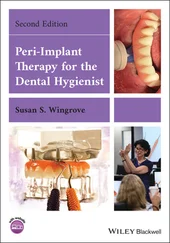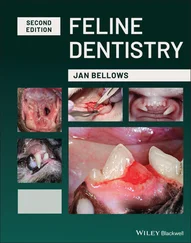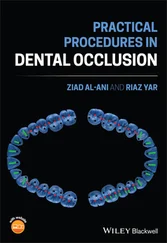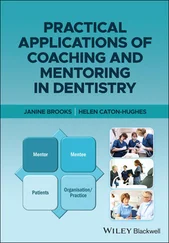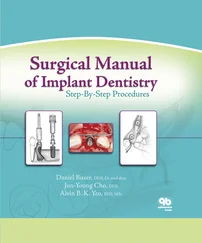Medical questionnaires are routinely used and, in addition, it is best practice to verbally ask specific questions about the health of patients. There are two basic questions that a clinician should ask prior to implant surgical procedures:
1 Is the patient fit medically to have the procedure done?
2 Is there anything in their history that would interfere with healing and the normal osseointegrative process?
These two simple questions should form the basis of your questioning as to whether patients are able to undergo a surgical procedure and determine any risk factors with the healing process. There are very few absolute contraindications to implant surgery, however there are certain conditions which may increase the risk of complications with the surgical procedure or wound healing. The conditions listed in Table 2.1have been suggested as possible contraindications to implant treatment and should be carefully managed.
Table 2.1 Relative contraindications to implant surgery.
| Diabetes |
| Tobacco use |
| Uncontrolled cardiovascular disease/hypertension |
| Cancer/leukaemia |
| Renal/liver problems |
| Bisphosphonate medications |
| Blood disorders/anticoagulant therapy |
| HIV/immunosuppression |
| Alcohol abuse |
| Psychological disorders |
| Pregnancy |
| Irradiation |
2.1.2 Medications and Allergies
A list of medications (including any herbal preparations or medications taken on as‐needed basis) along with the dosage and indications for the medication should be recorded. Patients should be asked whether they take any over‐the‐counter medications such as aspirin on a regular basis as they often forget to mention this when recording medications prescribed. Any allergies should be documented to preclude any reaction.
2.1.3 Past Medical History
Several conditions are discussed below, however further investigation is required if there is any uncertainty as to the prognosis.
2.1.3.1 Cardiovascular Disorders
Uncontrolled hypertension (blood pressure above 160/90 mmHg) places the patient at greater risk of stroke, heart failure, myocardial infarction, and renal failure. Implant surgery may therefore pose a risk to potential adverse cerebrovascular and cardiovascular events.
Patients who have had a cardiac infarction within the previous six months should not undergo surgery, and patients with a history of angina should have glyceryl trinitrate tablets/sublingual sprays available when undergoing implant surgery.
The use of antibiotic prophylaxis may be required for patients with a history of prosthetic valves, infective endocarditis, or rheumatic fever.
Anticoagulant therapy may cause extended bleeding post‐operatively, and patients taking warfarin or heparin should have an International Normalised Ratio (INR) of less than 2.5 prior to the surgical procedure. Consultation with the patient's physician is recommended to determine whether the patient should cease anticoagulant therapy such as aspirin.
2.1.3.2 Diabetes Mellitus
Diabetes mellitus is a common endocrine disorder affecting the metabolism of glucose. Patients with diabetes may experience increased susceptibility to wound‐healing complications and increased inflammatory destruction. Furthermore, they possess altered bone and mineral metabolism which may interfere with bone metabolism [3]. A prospective study of 89 patients with well‐controlled type 2 diabetes found an early failure rate of 2.2% in implants placed in edentulous mandibles. This increased to 7.3% after one year when the implants were loaded with overdentures [4]. The five‐year results of this study revealed a survival rate of 90% [5]. Diabetes mellitus is not a barrier to successful osseointegration provided the implants are placed in patients with well‐controlled diabetes.
Placement of implants in younger patients that are skeletally immature is contraindicated. Implants act like ankylosed teeth and hence lack the ability to erupt and compensate for changes in growth. This may lead to the implant submerging over time and may also interfere with the normal growth of the jaw. Individual assessment by serial cephalometric radiographs, one year apart, is needed to confirm that growth has truly ceased [6] prior to implant placement.
In the elderly patient, there is no upper age limit contraindication for implant therapy. However, the elderly patient may not be able to undergo prolonged surgical procedures, is likely to possess more systemic health factors and have decreased ability to adapt to new prostheses, may have poorer oral hygiene practices, and may require longer healing times due to changes in bone and calcium metabolism which can potentially affect osseointegration.
Nevertheless, the literature suggests that age does not have an impact on osseointegration of implants, nor survival of the implants after osseointegration.
It has been documented that smoking may impair wound healing through the vasoconstrictive effects of nicotine, which may compromise tissue perfusion and vascularity. This also may reduce the tissue capacity to combat infection.
Multiple studies demonstrate a significant relationship between smoking and higher failure rates of implants [2, 7, 8]. Bain and Moy [8] revealed that smokers had more than twice the percentage of implant failures when compared to non‐smokers (11.3 versus 4.8%). Two studies investigated the effect of smoking on initial healing of the implant [7, 9]. They showed smokers had a higher failure rate than non‐smokers, particularly in the maxilla.
Bain [7] found a statistically significant difference between smokers and non‐smokers, as well as between smokers and those who underwent a protocol of cessation of smoking during the period of implant placement and initial healing. Under the protocol suggested by Bain, patients are advised to cease smoking for a minimum of one week prior to and at least eight weeks after implant surgery. The short‐term implant success rates were similar to those who had never smoked. However, long‐term heavy smokers should be informed about the reduced success rate, especially for maxillary implants.
2.1.6 Osteoporosis and Bisphosphonate Therapy
Osteoporosis has been defined as a decrease in bone mass and bone density with an increased risk and/or incidence of fracture. Currently there is no evidence to suggest that clinical diagnosis of osteoporosis affects all parts of the skeleton uniformly. Thus, a diagnosis of osteoporosis in other parts of the skeleton does not presume that the maxilla and mandible are affected. A systematic review [10] reports no evidence for a higher failure rate of dental implants in the osteoporotic patient.
The mode of action of bisphosphonate and other osteoporosis‐related medications is to disrupt osteoclastic‐mediated bone resorption, and this may reduce bone deposition by osteoblasts with a reduction in bone resorption and bone turnover.
Medication‐related osteonecrosis of the jaw is a potential complication with long‐term use of bisphosphonates and complex surgeries. The impaired bone healing may leave exposed bone uncovered by mucosa resulting in chronic pain, infection, bone loss, and possible pathologic jaw fracture. The risk is increased in IV infusion therapy of these medications, other comorbidities, duration of medication usage, and the complexity of surgery.
In a postal survey, Mavrokokki et al. [11] estimated the risk of osteonecrosis of the jaw after dental extraction to be 0.09–0.34% with weekly oral alendronate (Fosamax) and 6.7–9.1% with IV formulations used for bone malignancy.
Читать дальше
